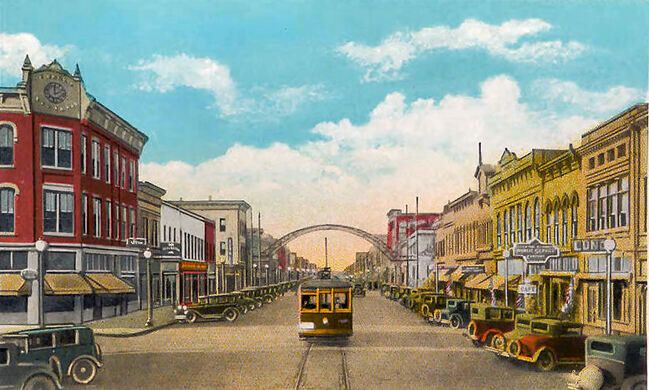Yours Truly is back after a very restful three-day Presidents' Day weekend. Blogger got a lovely Valentines Day present from #TeamNutmeg. That made Blogger's day. Another thing that made Blogger's day, a brand-new, light weight laptop. Yay. So happy. Now, we can have pictures again. Before we get started today, a housekeeping note. In April Google's social media site, Google +, is going away for good. You can still find posts on Facebook, Twitter, as well as the blogspot main page. Yours Truly will remind you again before the site shuts down. One more thing, Blogger is using a new device. Therefore, it is taking time to get adjusted to all the nuances of it, which means today's post will be split up over a couple of sessions. Shall we start today's post?
 |
| End of the road Santa Monica, California route66guide.com |
Be that as it may, the actual practice and process of American preservation faces a massive uphill battle "because rapid investment creates conditions that lead to demolition, often as a result of the false claim that it's the only way to add needed density" (citylab.com; Feb. 8, 2019). One example, a soon-to-be-released analysis of Miami's fast-growing Little Havana (savingplaces.org; Feb. 19, 2019) by the NTHP's Research and Policy Lab (Ibid) found "the district could easily accommodate 10,000 new residential units and accommodate 550 new businesses by building out vacant lots and utilizing vacant buildings to a height and scale compatible with existing structures" (Ibid).
 |
| Postcard of Cairo, Illinois atlasobscura.com |
In contrast, cold real estate markets have the opposite problem: "Valuable historic resources lie fallow because demand for space is low and the economics of rehabilitation can be extraordinarilyt challenging" (citylab.com; Feb. 8, 2019). Cairo, Illinois (npr.org; June 4, 2017; date accessed Feb. 19, 2019), a historic river front city is dealing with rapid depopulation. Oddly, it is the subject (atlasobscura.com; date accessed Feb. 19, 2019) of travelers' need for ruin porn (cnn.com: Nov. 1, 2017; date accessed Feb. 19, 2019).
The benefits and nascent challenges indicate the major way preservation strategies have changed over the past 50 years. However, the preservationist's toolkit has not chaneged along with the lanscape. The National Main Street Center has failed to keep pace with the preservation-based revitalization in the more than 1,100 communities in two specific ways: "Firstly, our core preservation tools do not serve all kinds of preservation well--and in fact can undermine our broader efforts to save buildings and support the people and enterprises that enliven those buildings. Secondly, our financing mechanism for building rehabilitation are inadequate to the task" (citylab.com; Feb. 8, 2019).
These challenges are not mere distractions from the more serious social, environmental, and economic issues facing American cities: "Everyone who care about quality of palce and values our collective story as Americans has a stake in this conversation" (Ibid). As do those who want to focus on the declining economy in rural America and the egregious lack of opportunity in many urban neighborhoods. Decisions about what is designation-worthy, how, and why resonate for generations. Those choices form and mirror our understanting of who we are at a particular time and profoundly affect revitilization opportunities in struggling comminity. Therefore, it is absolutely that we update the toolkit (not an actual toolkit, more like a series of strategies).
How badly in need is the preservationist's toolkit? If you studied preservation or are just preservation-minded, chances are that you know the what the Secretary of Interior's Standards of Historic Properties (nps.gov; date accessed Feb. 19, 2019) is. The handbook was drafted in 1977 with four sets of standards t's hat guide the care of historic propeties: preservation, rehabilitation, restoration, and reconstruction. Only modest changes have been made in the 42 years since its publication.
These modest updates fail to reflect the rapid urbanization and the corresponding decline of rural communities, major changes (good and bad) in real estate financing, the catastrophic affects of climate change, and much overdue realization of the importance of honoring and saving every facet of the American story.
In the next installment, we will address what kinds of updates the preservationist's toolkit needs.
In the next installment, we will address what kinds of updates the preservationist's toolkit needs.
No comments:
Post a Comment